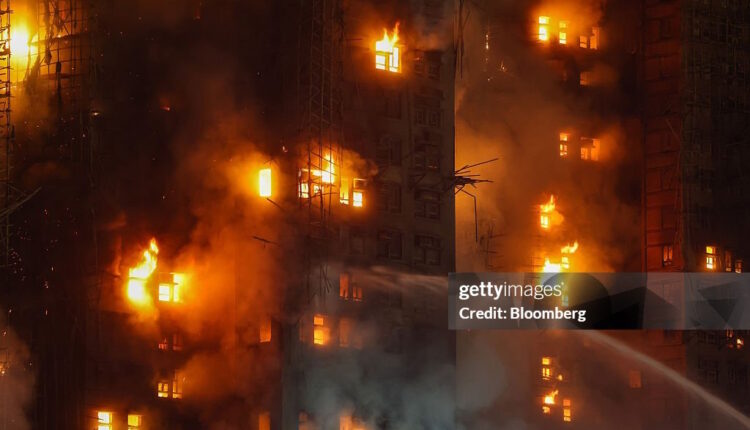HONG KONG – A devastating fire that raged through a densely populated public housing estate in Hong Kong has claimed at least 128 lives, marking the city’s deadliest blaze in over 70 years and plunging the community into a period of profound grief and searching questions.
The inferno, which began on Wednesday afternoon in the northern suburb of Tai Po, engulfed the Wang Fuk Court complex, a cluster of eight interconnected tower blocks housing nearly 4,600 residents. The death toll, which officials fear may still rise, has now surpassed the 1967 Mirador Mansion fire, which killed 67, and stands as the second-worst in Hong Kong’s history after a 1948 warehouse fire that killed 176.
A Firestorm Ignited
The first alarm was raised at 14:51 local time (06:51 GMT). With terrifying speed, the fire took hold, fueled by highly flammable Styrofoam insulation panels and construction netting draped across the buildings’ facades as part of an ongoing renovation project. Fire officials confirmed the blaze started on a lower floor before “chimneying” upwards, creating a vortex of intense heat that reached a peak temperature of 500°C (932°F).
By 18:22 local time, the fire had been upgraded to a “No. 5 alarm,” the most severe category, triggering a massive emergency response. At its peak, the fire raged across seven of the estate’s eight towers, presenting a nightmarish scene for the more than 2,311 firefighters who battled the flames.
“The intensity of the heat was such that the fire reignited in several locations even after being doused,” a fire department spokesperson said during a somber news conference. The fire was not declared fully extinguished until 10:18 local time on Friday, over 31 hours after it began.
A Community Shattered
The human cost of the disaster is staggering. In addition to the 128 confirmed dead, 79 people were injured, and dozens more remain unaccounted for. The fire department confirmed that 89 bodies have yet to be identified, and 16 remain inside the charred buildings, which are now considered a crime scene.
Authorities have launched a massive effort to identify the victims and support the survivors. A nearby community hall has been converted into a crisis center, where anxious families clutching photographs wait for news of missing loved ones. The government has set up temporary shelters and support centers for the hundreds of residents displaced by the fire.
Many survivors are traumatized and unwilling to speak. “There was nothing we could do. Together we watched our homes burn gradually,” said a former resident who only gave his surname, Chan.
The victims include 37-year-old firefighter Ho Wai-ho, who was found collapsed inside the complex after losing contact with his team. Twelve other firefighters were injured in the heroic but perilous operation. A migrant workers’ charity also confirmed that at least two Indonesian nationals, who had been working on the renovation, were among those killed.
“I’m concerned about friends I know… Usually we talk, and then I haven’t met them [since the fire],” said Fita, an Indonesian domestic worker who escaped the blaze, her voice trembling with worry.
Anger and Accountability
As the initial shock subsides, public grief has swiftly turned to anger. Critical questions are being raised about the safety protocols at the 40-year-old housing estate.
Multiple residents reported that they never heard a fire alarm. The Hong Kong Fire Service confirmed that the alarm systems in all eight blocks were “not working effectively.” One resident told the BBC that construction workers had deliberately turned off some alarms to avoid disruption during renovations.
Online, reports have resurfaced of residents’ prior complaints to the building management, questioning exorbitant renovation fees and whether the materials being used complied with fire-safety regulations. The widespread use of the flammable Styrofoam cladding, which acted as an accelerant, is now a central focus of the investigation.
“In the wake of this unimaginable tragedy, we have reason to believe that those in charge at the company were grossly negligent, which led to this accident and caused the fire to spread uncontrollably, resulting in major casualties,” a police spokesperson stated.
Authorities have arrested three individuals overseeing the renovation project on suspicion of manslaughter and have launched a separate corruption inquiry. Police are set to begin a meticulous evidence-gathering process inside the unstable towers, with a full investigation expected to take three to four weeks.
The disaster has cast a harsh light on the living conditions and safety standards in Hong Kong’s aging public housing stock, particularly for its most vulnerable residents. Nearly 40% of Wang Fuk Court’s population is estimated to be over the age of 65, many of whom had lived there since it opened in 1983. For a city that prides itself on order and efficiency, the Wang Fuk Court fire stands as a devastating failure and a tragedy that will haunt its collective memory for generations.
Support Dawat Media Center
If there were ever a time to join us, it is now. Every contribution, however big or small, powers our journalism and sustains our future. Support the Dawat Media Center from as little as $/€10 – it only takes a minute. If you can, please consider supporting us with a regular amount each month. Thank you
DNB Bank AC # 0530 2294668
Account for international payments: NO15 0530 2294 668
Vipps: #557320



Comments are closed.